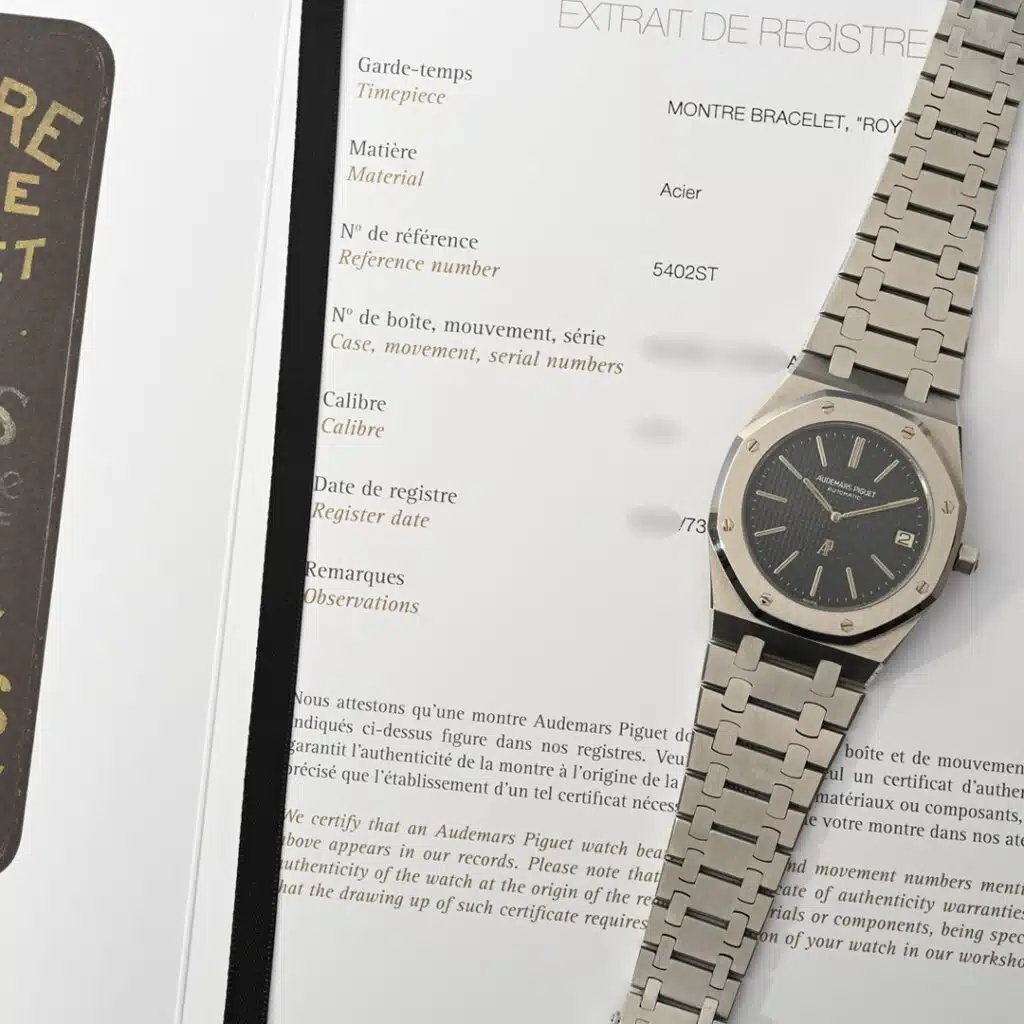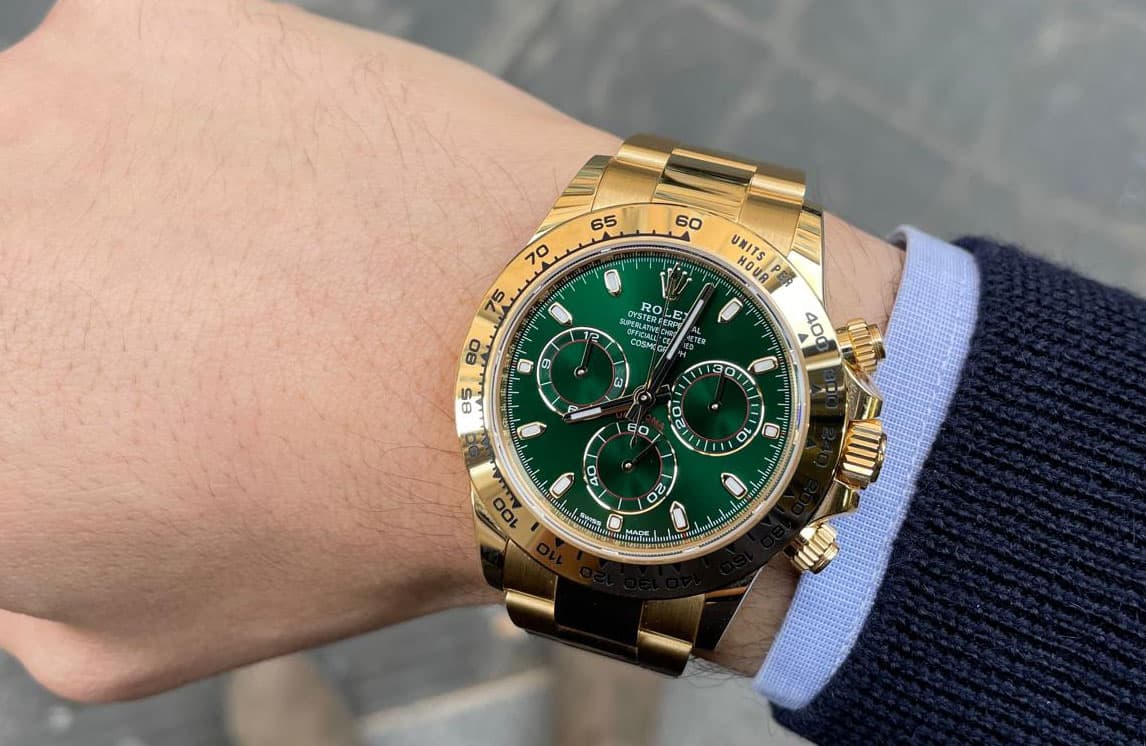Legend has it that it was designed overnight by Gérald Genta; what we are certain of is that the first Royal Oak model was unveiled in 1972 at the Basel Fair, after two years of development.
This extraordinary watch elevated steel to a new status. Introducing the concept of "casual chic," it opened a chapter in the history of Audemars Piguet and Haute Horlogerie. In 1977 it was first available in precious materials: yellow gold, white gold and two-tone.
Everyone thinks that the "magic" numbers of the Royal Oak, the ones that made it iconic, are 39, or the millimeters of the case that is unquestionably more balanced for its design, and 5402, which reminds us of the first reference in 1972. In reality the myth was born, also in a non-random way as we will find out in the continuation of this article, thanks to the rarity of the first pieces made, those phantom one thousand pieces, whose numbering was done specifically to give a sense of uniqueness to a watch that was actually designed from the beginning for series production.
Its collector's and historical importance is given by the low number of its case (as we shall later see, watches were not always distributed in numerical order), which highlights it as one of the very first specimens produced, which is complemented by a decidedly excellent state of preservation, also in view of the age of the watch itself and the fact that at that time models of this kind were bought to wear, indeed to display proudly, not certainly to make a financial speculation out of them.
So everything in this 5420ST manages to amaze and engage, becoming the not-so-secret dream of all major collectors who also have a keen eye for the market.
Royal Oak ref. 5402
Case: 39mm. Functions: hours, minutes, date. Movement: automatic Caliber 2121. Dial: Tapisserie 21. Bracelet: integrated tapered 344. One-piece case water-resistant to 100 m.Date of launch.: 1972 (ST steel) and 1977 (BA, BC, SA).
Legend has it that it was designed in one night by Gérald Genta., what we are certain of is that the first Royal Oak model was presented in 1972 at the Basel Fair, after two years of development. This extraordinary watch elevated steel to a new status. Introducing the concept of "casual chic," it opened a chapter in the history of Audemars Piguet and Haute Horlogerie. In 1977 it was first available in precious materials: yellow gold, white gold and two-tone.
Originally planned for a run of 1,000 units, ref. 5402 was produced in 6,050 units, sold between 1972 and 2002.
Models derived from 5402: 4187 (1979); 4276 (1981).
Other Royal Oak "Jumbo" variants with dates: 14802 (1992), 15002 (1996), 15202 (2000), 15128 (2003), 15201 (2011), 15205 (2015), 16202 (2022).
Let's look specifically at the production numbers.
Between 1972 and 1976, the Royal Oak 5402 was the only Royal Oak produced by Audemars Piguet that was available in a single material and with a single dial. In these four years alone, this model made its mark in the world of Haute Horlogerie before being launched, starting in 1976, in one of the most prolific collections in watchmaking history.
-
The 5402ST remained in the catalog for 15 years.
Total number of watches sold: 4,288 .
-
Serial A: No. A1-A1999. Total sales 1,937 watches. 490 (1972), 543 (1973), 614 (1974), 243 (1975), 7 (1976), 13 (1977), 4 (1978), 6 (1979), 10 (1980), 2 (1981), 2 (1982), 1 (1983), 1 (1984), 1 (1989)
Numbering: 1-2000
Serial B: No. B1001-B2000. Total sales: 845 watches. 228 (1975), 569 (1976), 23 (1977), 3 (1978), 7 (1979), 7 (1980), 4 (1981), 1 (1986), 1 (1987), 1 (1992), 1 (1993)
Numbering: 1000-2000
Serial C: No. C1001-1973. Total sales: 952 watches. 10 (1976), 459 (1977), 234 (1978), 223 (1979), 15 (1980), 5 (1981), 4 (1982), 1 (1984), 1 (1987)
Numbering: 1000-2000
Serial D: No. D1000-1410 Total sales: 404 clocks. 1 (1978), 15 (1979), 129 (1980), 87 (1981), 70 (1982), 53 (1983), 20 (1984), 10 (1985), 6 (1986), 5 (1987), 7 (1988), 1 (1989)
Numbering: 1000-1500
Without small case number: Total sales: 129 clocks. 1 (1974), 120 (1975), 5 (1977), 1 (1979), 1 (1989), 1 (1994)
Without letters: total sales: 21 clocks. 5 (1988), 10 (1989), 6 (1990)
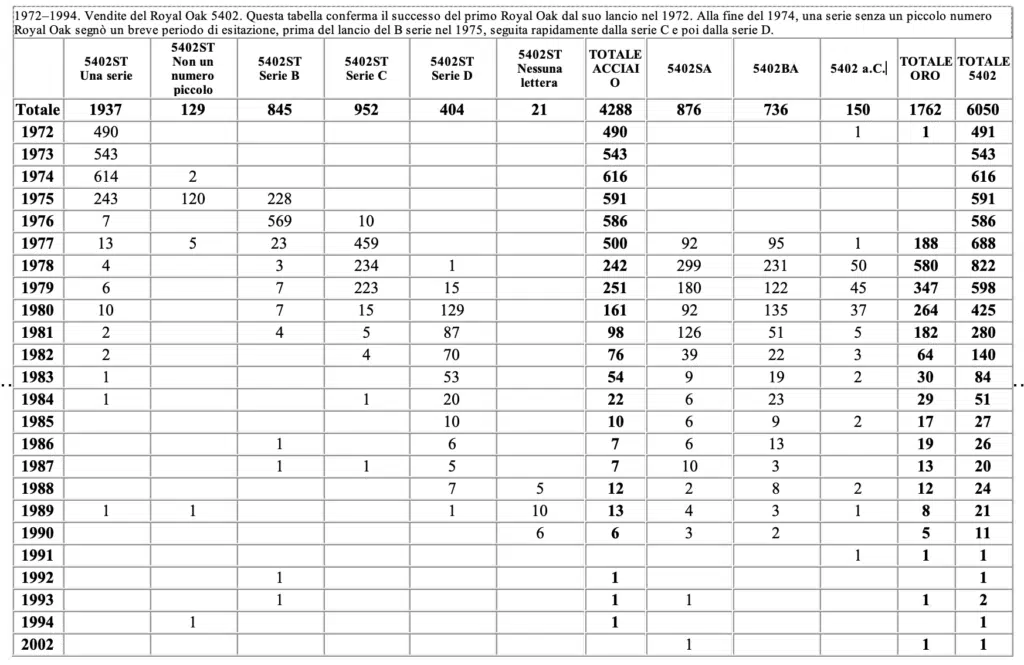
In 1972, Audemars Piguet's introduction of the Royal Oak represented a revolution in the watch numbering system adopted by the company since its founding nearly a century earlier. With the emergence of this model, a new numbering scheme was introduced, comparable to that used for limited editions, where a "small number" was assigned to each piece of the Royal Oak, emphasizing its exclusivity and rarity. Initially, A, B, C and D series were introduced for the 5402ST model, but this system was abandoned in 1976 in favor of numbering that no longer made use of letters, a method that remained in use until the early 2010s.
Before the appearance of the Royal Oak, Audemars Piguet followed a traditional method for numbering its watches, marking each piece with one or more unique numbers engraved on the movement and case, which were then meticulously recorded in the company's records. This system ensured the long-term identifiability and authenticity of each watch, allowing the possibility of restoration faithful to the original condition. Considering the designed longevity of mechanical watches, which can run for decades or centuries, the importance of an accurate numbering system is unquestionable.
In detail, each movement had a unique "movement number", assigned sequentially since the 19th century, which had reached the number 115,000 by 1970. This number was accessible only to watchmakers, as it was visible only by opening the watch case to examine the inner mechanism.
Analogously, watch cases were marked by a unique number, usually engraved on the back, with a sequence begun in 1951 by the number 1, which had surpassed 60,000 by 1970. After reaching 100,000 in 1975, the numbering was restarted from B1 up to B99999, circa 1986, and then with the C series from C1 to C99999, and so on.
Each watch was also identified by a specific model number and contained a mechanism identified by a unique caliber number. These numbers, intended primarily for watchmakers or retailers, were often unknown to watch owners and only acquired meaning when compared with Audemars Piguet's corresponding archives and records.
The Royal Oak made a name for itself despite its high price, use of innovative materials, and unconventional size, recording astonishing sales with nearly 1,000 units sold only a year after its launch. This success led Georges Golay, then director of Audemars Piguet, to increase production to 2,000 units. Despite some inconsistencies in numbering, the A series ended up including 1,937 Royal Oak watches sold between 1972 and 1989.
In late 1974, doubts emerged about the future of this unique and innovative model. While a final decision was awaited, 129 Royal Oak 5402ST watches without a "small number" were produced and distributed, with 90 percent of these sold between January and September 1975. Subsequently, production of the B series, which used the numbers B1000 to B2000, was started. It is unclear why the numbers 1 to 1,000 were not used for the B series, but it is speculated that Golay wanted to reserve the numbers below 1,000 exclusively for the A series. On March 21, 1975, the first Series B watch was shipped from Le Brassus with the number B1044, destined for the island of Guam. Between 1975 and 1993, a total of 845 B-series watches were sold.
December 1, 1976 was the start date for the C series of the Royal Oak, with the production of 952 pieces, numbered C1000 to C2000, which continued to be sold until 1987. It was then the turn of the D series, which counted 404 examples distributed between 1977 and 1989. The final variant turned out to be extremely rare: between 1988 and 1990, only 21 Royal Oak 5402ST watches were produced with a "small number," continuing the numbering of the 5402SA models but without the addition of letters, thus ending the numbering history of the first steel Royal Oak.
The Serial A (thanks to mstanga who published the following text in his volume "Audemars Piguet Royal Oak 5402)
To better understand the complexity and singularity in the numbering of ref. 5402 with serial A, we resort to what Marco "mstanga", recognized as one of the most attentive and authoritative connoisseurs of this model, writes.
"We have noticed by observing and analyzing 30-40 examples of ref. 5402ST that in front of the external numbering of the case back, corresponds an internal numbering of the same that follows precise rules: the last three digits of the number indicated on the external case back, are repeated in the internal case back with a prefix that varies at determined intervals, in the case of a number composed of less than 3 digits (example A89) a zero is added."
This is the table of prefixes:
Serials A 1 to 9: 6700
Serials A from 10 to 99: 670
Serials A from 100 to 1,000: 67
Serials A from 1,000 to 2,000: 80
Serials B from 1,001 to 2,000: 99
Serials C from 1,001 to 2,000 B3
Serials D from 1,001 to ?: B28 and B29
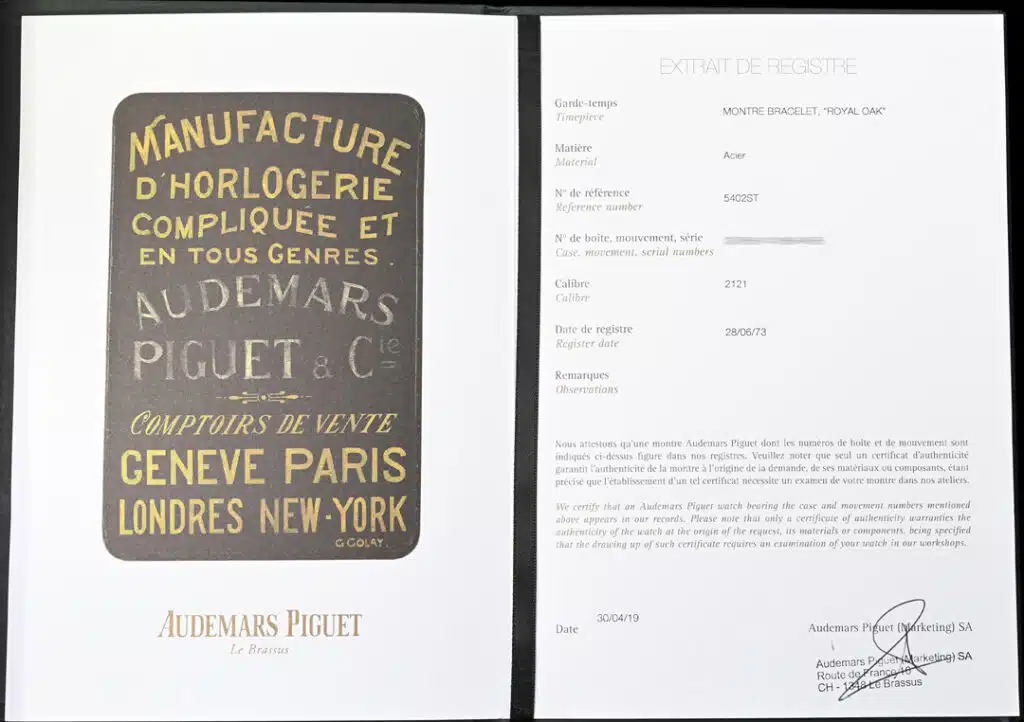
Can the production era of model 5402 be determined through its "small number"?
Often, whether collectors, auction house operators, or simply enthusiasts, try to infer the marketing date of a watch based on the small number engraved on the case. Unfortunately, similar to movement numbers and large numbers engraved on the case, small numbers do not provide a reliable method of accurately dating a watch, as the distribution of watches did not follow a sequential order. For example, the Royal Oak 5402ST with serial number A859 was sold two years after the model with serial number A860.
Nevertheless, with rare exceptions, analysis of company records reveals that the small number can generally help circumscribe the watch to a specific time frame.
1972-1986 . This is the approximate time frame for dating the Royal Oak 5402 based on the small number on the case. A rough estimate of the date of the first sale of the Royal Oak 5402 can be conjectured thanks to the small number engraved on the case back. However, the precise date can only be verified through a detailed examination of the watch, conducted by Audemars Piguet's Heritage department.
5402ST
A1-A500 1972-1973
A500-A1000 1972-1974
A1000-A1500 1973-1975
A1500-A2000 1974-1976
Unnumbered 1974-1976
B1000-B1500 1975-1977
B1500-B2000 1975-1977
C1000-C1500 1976-1978
C1500-C2000 1978-1980
D1000-D1500 1979-1985
5402BA
1-500 1977-1980
500-1000 1980-1986
5402SA
1-500 1977-1980
500-1000 1979-1983
5402 BC
1-150 1977-1981
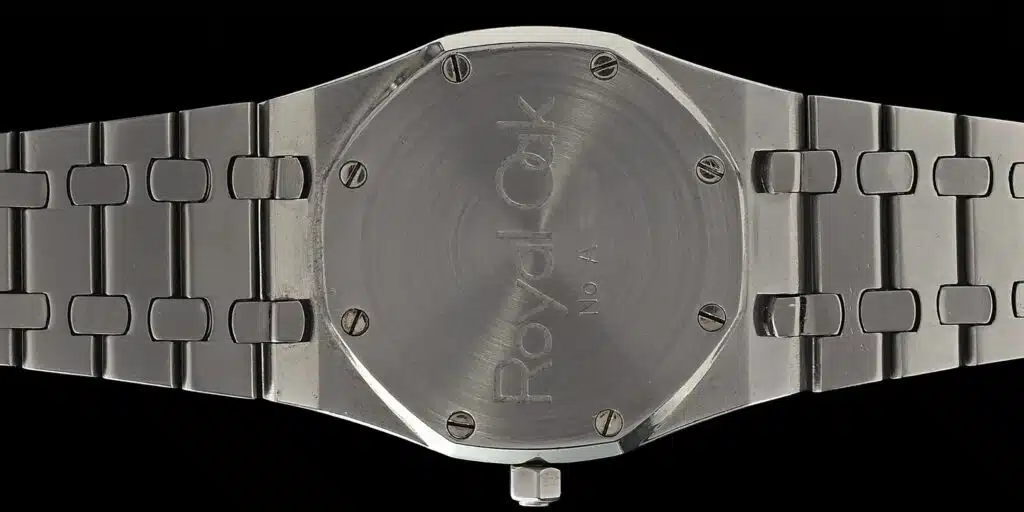
Numbers and their special meanings
Often, numbers take on symbolic value. Thus, when minor serial numbers were introduced on dials in the 20th century, many buyers requested to be able to purchase models with numbers corresponding to significant dates in their lives, such as the year of birth or the founding of an enterprise, and so on.
It is said that the first Royal Oak 5402ST watches were assigned according to a particular logic: even numbers went to the Italian agent Carlo de Marchi, and odd numbers to the Swiss agent Charles Bauty. This distribution is indeed confirmed by the archives, but they specify how it was not a fixed rule and that this system was not applied beyond the A100 number. Several stories circulate about Royal Oak 5401ST number A1.
It is said to have been given to Emanuel of Savoy, but archival documents reveal the surname Fradkoff, which likely refers to Harry Winston's Serge Fradkoff. As for the Shah of Persia, archives indicate that he purchased the first Royal Oak in white gold, marked with the number 101. Another detail that some collectors have observed is that the last three digits of the major number on the case often correspond to the minor number for most A, B and C series, a fact confirmed by studies of the registers.
End of the alphanumeric system
In 1976, with the launch of the first women's Royal Oak, Model 8638, the issue of numbering again arose. Although the alphanumeric method used for model 5402ST had served its commercial purpose well, it revealed its limitations.
Why did the B series have to start from 1000?
Why limit production to only 500 watches for the D series?
Up to what letter could this system continue?
This is without counting the confusion between the B in the major number and the B in the minor number (see next section). To simplify, the letter was eliminated.
From that point on, each new Royal Oak model would have a minor number beginning with 1, increasing progressively with each different material and throughout the model's production life. So, for example, the 4100 model launched in 1977 had three variations with the number 1: one in steel, one in gold, and one two-tone.
The new system was also applied to the Model 5402 in 1977, when Audemars Piguet decided to introduce gold variants. The first 5402BA in yellow gold-with the minor number 4 and the major number B12753-was shipped from Switzerland to Japan on June 8, 1977. The BA variant was sold in 736 pieces between 1977 and 1990, covering numbers 1 to 745.
The steel and gold 5402SA variant was produced in 876 units (numbers 1 to 951), and the rarer white gold version exhausted all numbers in the series, from 1 to 150, a rather unusual case. 1972-1993. Sales of the gold and two-tone versions of the Royal Oak 5402. Prior to 1977, only one gold Royal Oak had been offered for sale for the Shah of Iran.
Almost simultaneously, yellow gold (BA), two-tone (SA, which combined steel and yellow gold) and white gold (BC) variants were introduced. Their production slowed in the early 1980s, coinciding with the introduction of smaller models such as the 8638 (29 mm), the 4100 (35 mm), followed by the 4332 (36 mm), and so on.
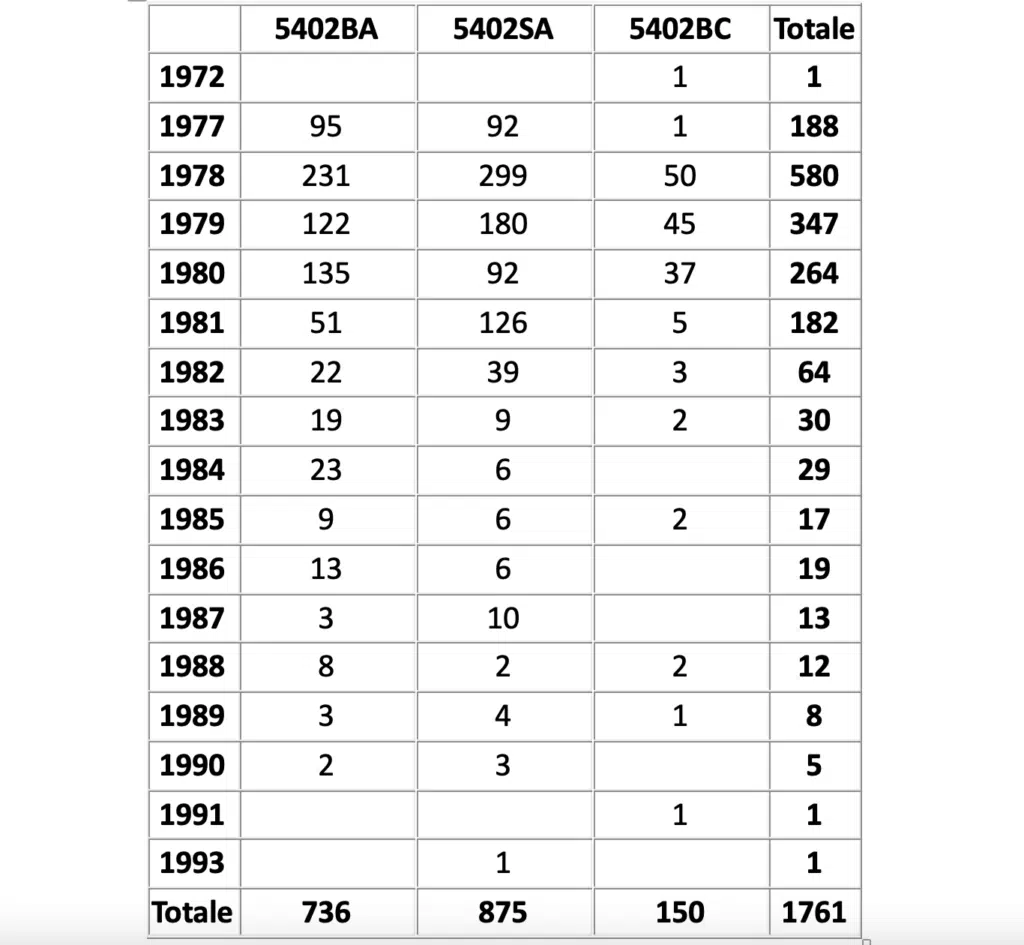
The debut of the Royal Oak
In 1972, the introduction of Audemars Piguet's Royal Oak raised significant questions about the perceived value of these new watches. There were plans to produce 1,000 identical pieces, a quantity never previously achieved at Le Brassus. At a time when Audemars Piguet's customers were accustomed to single pieces or small series, how could a feeling of exclusivity be maintained with 1,000 identical watches?
The situation was further complicated by the fact that the Royal Oak was made of steel, a material considered less noble, but its case was of such complexity that it cost as much as gold. Other steel watches of the time, such as the Oyster, the Seamaster or the Speedmaster, were produced in the tens of thousands and sold at a much lower price. Georges Golay, then director of the company, found a brilliant and simple solution.
He decided to hide the "large case number" inside the watch, reserving it for the attention of watchmakers, and instead engrave a serial number on the back of each Royal Oak 5402, starting with 1 and increasing progressively. This number assured the owner that he or she had a unique piece and that production was limited. This gave rise to the "small case number," also known as the "Royal Oak number." The B serial The first appearance of high numbers beginning with the letter B in the records occurred between 1976 and 1977, almost concurrently with the first Royal Oak B series.
This coincidence has been able to generate confusion among collectors. Therefore, it is useful to clarify here. "B series" of Model 5402ST means an original steel Royal Oak with a small external number engraved under the name Royal Oak, located between B1000 and B2000. It would be incorrect to consider a watch with a large (inner) case number beginning with the letter B as belonging to the B series. For example, a model 5402ST, part of Audemars Piguet's Heritage collection, with the small number C1709 and sold in 1979, has a large case number B3709, but belongs to the C series. This confusion has sometimes extended to yellow gold models as well.
Most 5402BAs have large case numbers beginning with B. However, according to recognized standards in the museum and collector world, these are not considered B series. The small case numbers of the precious metal variants have no letters. For example, the Royal Oak 5402BA No. 27, sold in June 1977, has a large case number B14661 engraved on the inside, but it is not B-series, but 5402BA No. 27-this is because the letters had been removed from the small number before the first gold 5402 model was produced.
Evolution of the numbering system
The "small case number" system, or "small Royal Oak number," was introduced in 1972 to enhance the prestige of the new model. This system accompanied the increase in production from hundreds to thousands of identical watches, operating as a limited series but without a defined maximum threshold, taking advantage of the fact that the quantities produced by Audemars Piguet are traditionally limited.
Since the early 1990s, this system has also been used for limited editions, specifying the print run (e.g. , XX/75 for an edition of 75 pieces). In 1976, the alphanumeric system in use for the 5402ST was replaced with a more direct numbering method. Although this system was suitable at the time of the creation of the Royal Oak collection, it became inadequate with the introduction of numerous variants of the Royal Oak in the 1980s.
Model identification became difficult without opening the case to check the large number, so the system had to evolve again. Around 1990, the large number on the case returned to being engraved on the outside, next to the small number, and with the introduction of visible casebacks, the small number was moved to the top of the caseback. For collectors, it is worth noting that there are exceptions to the rule that small numbers on models made of different materials begin with 1. In some cases, to create a Royal Oak series with minor modifications, such as set with gems and derived from a main model produced in hundreds of units, watchmakers used cases already numbered for the main series. This resulted in watches with small numbers exceeding the total production of the model.
Af example, Model 5402BA, produced in 736 examples, was used for the Royal Oak 4187BA gem-set variant, with some cases numbered as 420, 519, or even 637, despite the fact that only 9 examples of this variant are documented in the Audemars Piguet archives. Similar practices are observed for other variants other than the jeweled ones. In the second half of the 2010s, the system was completely revamped.
The small Royal Oak number has been eliminated and the movement numbers, along with the large case numbers, have become random and alphanumeric. This new system strips the numbers of their time or quantity value, with the aim of decreasing the risk of counterfeiting. Advanced computer tools are required to access the authentication information, thus reducing written records to a symbolic role and marking a new chapter in Audemars Piguet's history.
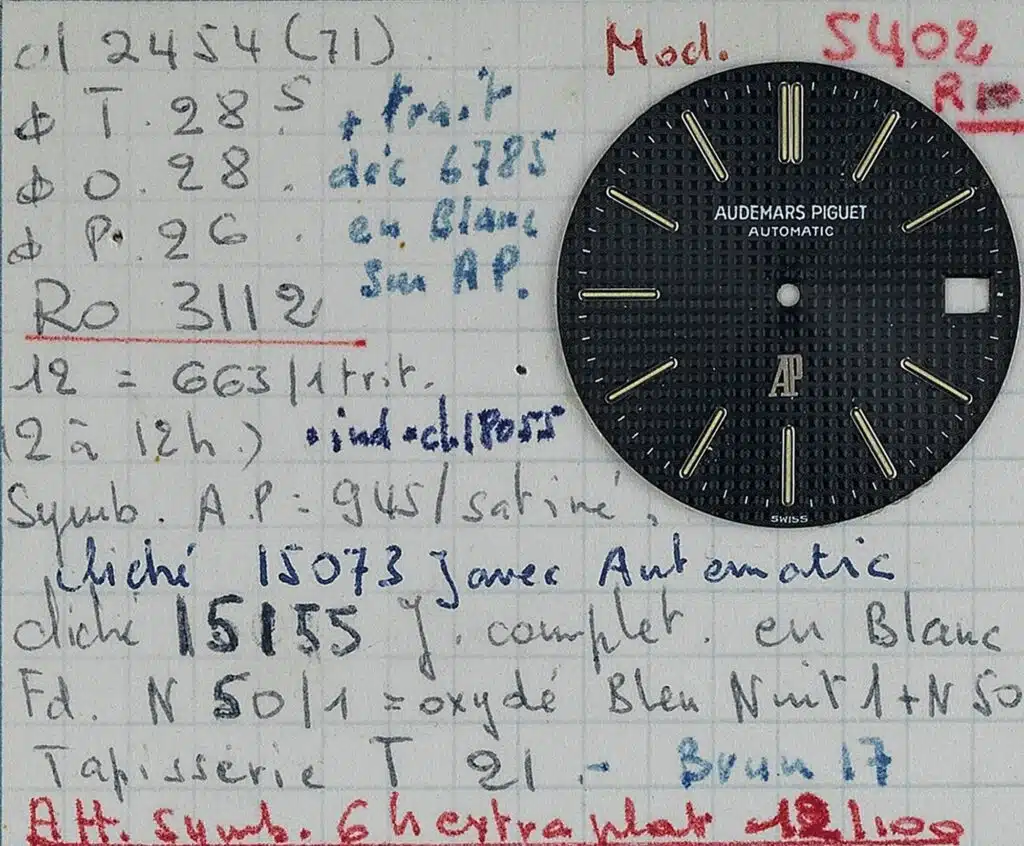
The dial design of the Model5402 is a masterful example of the harmonious integration of two essential geometric figures: the circle and the square. This fusion is not just a matter of aesthetics, but carries deeper meanings, playing on the contrast between linearity and curvature, rigidity and fluidity, thus symbolizing a coexistence between rigid discipline and more adaptable flexibility. The circular component is emphasized by the presence of twelve applied hour markers that, together with the minute markers, outline the perimeter of the dial. These are further enhanced by a myriad of minute diamonds, set in a series of concentric circles that capture and reflect light in an extraordinary way.
In parallel, the square geometry finds expression in an intricate pattern of hundreds of small, flattened pyramids arranged in a precise checkerboard configuration. These pyramids are intersected by horizontal and vertical lines, evocative of urban streets, giving the dial a distinctive geometric structure. The central axis of the dial, marked by the double index at noon and the AP monogram at six o'clock, emphasizes verticality, while horizontality is underscored by the AUDEMARS PIGUET signature, accompanied by the words AUTOMATIC and the presence of a date porthole positioned at three o'clock. This element introduces a calibrated asymmetry that, paradoxically, contributes to the aesthetic balance of the dial, reflecting the notion that harmonious beauty often lies in a slight irregularity.
This refined geometric composition gains further significance when considered in relation to the faceted structure of the Royal Oak's case, which also plays with geometric shapes. The bezel features a beveled octagonal design, while the one-piece case adopts the shape of a tonneau. This interaction between the case and dial not only contributes to a coherent overall aesthetic but also amplifies the watch's ability to capture and reflect light, creating a dynamic play of reflections through the superimposition of different geometries.
Theorigin of the dial design lies in a context of fortuitous serendipity, when the Stern company in Geneva, heir to ancient guilloché machines, proposed to designer Gérald Genta that they employ them to forge the appearance of the future Royal Oak. This collaboration led to the choice of a particular design and the decision to adopt a galvanic treatment for the coloring of the dial. With the closing of Stern Créations in 2016 and the subsequent distribution of part of its archive to historical clients, Audemars Piguet found itself in possession of a documentary treasure trove that included valuable details about the Royal Oak's first dial, including the "Tapisserie T21" motif, the "Bleu Nuit 1 + N50" color, and the technical specifications of the hour markers and AP monogram.
The "Tapisserie T21," or Petite Tapisserie, motif features a design that, although inspired by the traditional Clous de Paris, stands out for its uniqueness and finesse, helping to define the visual identity of the Royal Oak collection since 1976. Over time, this pattern has undergone evolutions and variations, including the introduction of a larger version, the Grande Tapisserie, but it was the Petite Tapisserie that made its triumphant return in 2012, on the occasion of Royal Oak's 40th anniversary, confirming its iconic position within the collection.
-
